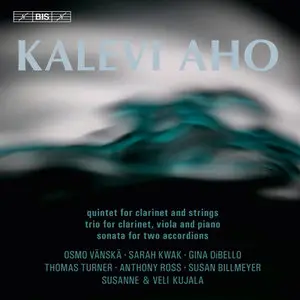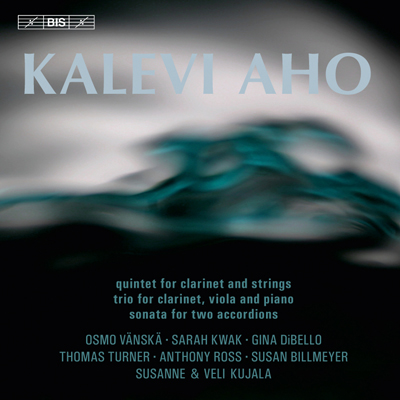Aho: Chamber Works - Vanska, Kujala, Kwak, Dibello, Turner, Ross, Billmeyer (2012)
EAC Rip | Flac (Image + cue + log) | 1 CD | Full Scans | 334 MB
Genre: Classical | Label: Bis | Catalog Number: 1886
EAC Rip | Flac (Image + cue + log) | 1 CD | Full Scans | 334 MB
Genre: Classical | Label: Bis | Catalog Number: 1886
Renowned for his rich production in the field of orchestral music, Kalevi Aho is also a prolific composer for chamber forces. On this disc, three works spanning two decades have been combined.
Opening the disc is the large-scale Clarinet Quintet, composed in 1998. Osmo Vänskä, better known as a conductor, began his career as principal clarinet in the Helsinki Philharmonic and appeared in the premiere performance of the quintet.
The Sonata for two accordions was written in 1984 as a Sonata for solo accordion described by the composer as ‘comparable in aspiration with Liszt’s most virtuosic piano works’. It was premièred as late as 2002 by Veli and Susanne Kujala, who also perform it on this recording.
The Trio for clarinet, viola and piano was commissioned to be the set chamber music work of the 2006 Tampere Viola Competition.
Composer: Kalevi Aho
Performer: Sarah Kwak, Osmo Vänskä, Thomas Turner, Gina Dibello, …
Reviews: The clarinet has been well served by Finnish composers in recent years. Magnus Lindberg, Kaija Saariaho, and Sebastian Fagerlund have all written substantial works for the instrument, each exploring different aspects of its technical and expressive potential. Kalevi Aho also follows his own unique path, although he remains more conservative than his three compatriots. But all fall under the long shadow of Sibelius, with expansive vistas, long phrases, and gradually evolving ideas dictating the pace and structure of their music.
Aho’s Clarinet Quintet is a substantial work in five movements, although attacca connections between them transform the structure into two long paragraphs. This is music on a grand scale, and every new idea is carefully prepared and cautiously introduced. We typically hear swirling, legato phrases from the clarinet, supported by intricate but resolutely diatonic textures in the strings. The clarinet occasionally gives a few growls or flutters, but that’s the limit of the extended performing techniques. The music always has a strong linear focus, but the Nordic chill in Aho’s aesthetic means that these lines always fall short of becoming distinctive melodies.
The Trio for Clarinet, Viola, and Piano inhabits a similar sound world, but sets up a very different relationship within its ensemble. The work was written for a viola competition, forcing both the composer and the listener to challenge the assumption that the clarinet should predominate. Aho squares this circle by giving the three players almost equal prominence, although with a very slight emphasis on the viola. In order to make these subtle interactions perceptible, Aho lightens his textures yet further, and only just reaches the bare minimum of excitement and interest required to support the work’s 13-minute duration.
The identity of the clarinettist will come as a surprise to many. Osmo Vänskä, it turns out, took an unusual path to the conductor’s podium via the principal clarinet chair. His most notable position as a player was as principal clarinet with the Helsinki Philharmonic in the late ’70s and early ’80s. Now, of course, he is chief conductor of the Minnesota Orchestra, and the group he has assembled for these chamber works is made up of the orchestra’s section principals. They give technically assured performances, subtly phrased and always nuanced in texture. Above all, these readings work because the players are able to create the ideal atmosphere for the music, spacious and open but never unduly relaxed. The high-quality audio from BIS helps, especially in the many entries where the clarinet enters dal niente , an effect that falls flat if the engineering can’t give the player the required sense of spatial focus.
The Sonata for Two Accordions is another substantial piece, which Aho himself compares in scale to the longer piano works of Liszt. It grew out of a virtuoso sonata for one accordion, although there is clearly sufficient material and inspiration here to keep at least two players busy. As with the clarinet, Aho avoids extended playing techniques on the accordion, so there is none of the heavy breathing from the bellows or chromatic cluster glissandos that characterize Gubaidulina’s writing for the instrument. Instead, the music is based on Baroque contrapuntal forms, prelude, passacaglia, and fugue. Aho demonstrates that accordion duet is the ideal vehicle for intricate polyphony. The voices come through the texture with the utmost clarity, and although the music poses exceptional technical challenges to the players, it always feels idiomatically suited to their instruments. The sonata is a curious choice to complete this program, but it turns out to be the most adventurous and satisfying work on the disc.
Tracklisting:
1. Quintet for Clarinet and Strings by Kalevi Aho
Performer: Sarah Kwak (Violin), Osmo Vänskä (Clarinet), Thomas Turner (Viola),
Gina Dibello (Violin), Anthony Ross (Cello)
Period: 20th Century
Written: 1998
2. Trio for Clarinet, Viola and Piano by Kalevi Aho
Performer: Osmo Vänskä (Clarinet), Thomas Turner (Viola), Susan Billmeyer (Piano)
Written: 2006
3. Sonata for 2 Accordions by Kalevi Aho
Performer: Veli Kujala (Accordion), Susanne Kujala (Accordion)
Exact Audio Copy V1.0 beta 3 from 29. August 2011
EAC extraction logfile from 16. August 2012, 1:15
- / Aho - Clarinet Quintet; Sonata for Two Accordions
Used drive : HL-DT-STDVDRAM GSA-4083N Adapter: 1 ID: 0
Read mode : Secure
Utilize accurate stream : Yes
Defeat audio cache : Yes
Make use of C2 pointers : No
Read offset correction : 667
Overread into Lead-In and Lead-Out : No
Fill up missing offset samples with silence : Yes
Delete leading and trailing silent blocks : No
Null samples used in CRC calculations : Yes
Used interface : Native Win32 interface for Win NT & 2000
Used output format : User Defined Encoder
Selected bitrate : 896 kBit/s
Quality : High
Add ID3 tag : No
Command line compressor : C:\Program Files\Exact Audio Copy\Flac\flac.exe
Additional command line options : -V -8 %source%
TOC of the extracted CD
Track | Start | Length | Start sector | End sector
––––––––––––––––––––––––––––-
1 | 0:00.00 | 10:04.46 | 0 | 45345
2 | 10:04.46 | 5:29.17 | 45346 | 70037
3 | 15:33.63 | 7:50.22 | 70038 | 105309
4 | 23:24.10 | 6:16.21 | 105310 | 133530
5 | 29:40.31 | 6:11.14 | 133531 | 161369
6 | 35:51.45 | 13:17.11 | 161370 | 221155
7 | 49:08.56 | 12:55.40 | 221156 | 279320
8 | 62:04.21 | 13:05.57 | 279321 | 338252
Range status and errors
Selected range
Filename J:\Music\Aho - Clarinet Quintet; Sonata for Two Accordions\Aho - Clarinet Quintet; Sonata for Two Accordions.wav
Peak level 99.8 %
Extraction speed 4.4 X
Range quality 100.0 %
Test CRC 97D0B6C7
Copy CRC 97D0B6C7
Copy OK
No errors occurred
End of status report
==== Log checksum 629E54CF2FEC05542F0BD0075486BF109D07F68704FEE6A5BD0375AEA9EC5D61 ====
EAC extraction logfile from 16. August 2012, 1:15
- / Aho - Clarinet Quintet; Sonata for Two Accordions
Used drive : HL-DT-STDVDRAM GSA-4083N Adapter: 1 ID: 0
Read mode : Secure
Utilize accurate stream : Yes
Defeat audio cache : Yes
Make use of C2 pointers : No
Read offset correction : 667
Overread into Lead-In and Lead-Out : No
Fill up missing offset samples with silence : Yes
Delete leading and trailing silent blocks : No
Null samples used in CRC calculations : Yes
Used interface : Native Win32 interface for Win NT & 2000
Used output format : User Defined Encoder
Selected bitrate : 896 kBit/s
Quality : High
Add ID3 tag : No
Command line compressor : C:\Program Files\Exact Audio Copy\Flac\flac.exe
Additional command line options : -V -8 %source%
TOC of the extracted CD
Track | Start | Length | Start sector | End sector
––––––––––––––––––––––––––––-
1 | 0:00.00 | 10:04.46 | 0 | 45345
2 | 10:04.46 | 5:29.17 | 45346 | 70037
3 | 15:33.63 | 7:50.22 | 70038 | 105309
4 | 23:24.10 | 6:16.21 | 105310 | 133530
5 | 29:40.31 | 6:11.14 | 133531 | 161369
6 | 35:51.45 | 13:17.11 | 161370 | 221155
7 | 49:08.56 | 12:55.40 | 221156 | 279320
8 | 62:04.21 | 13:05.57 | 279321 | 338252
Range status and errors
Selected range
Filename J:\Music\Aho - Clarinet Quintet; Sonata for Two Accordions\Aho - Clarinet Quintet; Sonata for Two Accordions.wav
Peak level 99.8 %
Extraction speed 4.4 X
Range quality 100.0 %
Test CRC 97D0B6C7
Copy CRC 97D0B6C7
Copy OK
No errors occurred
End of status report
==== Log checksum 629E54CF2FEC05542F0BD0075486BF109D07F68704FEE6A5BD0375AEA9EC5D61 ====
Thanks to the original releaser



